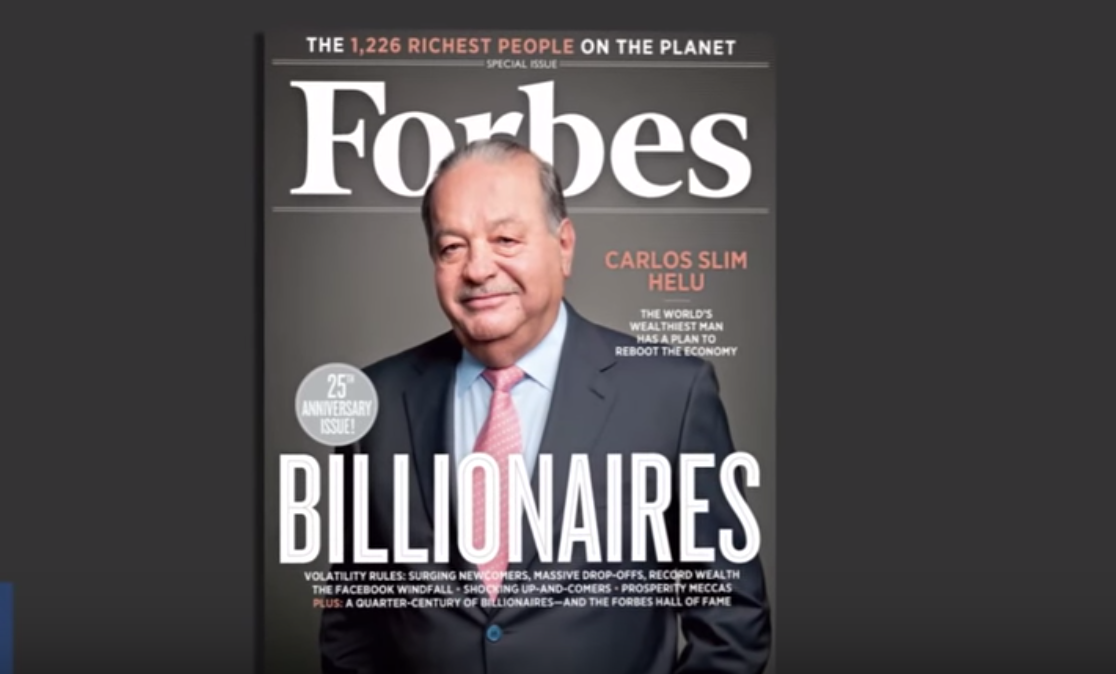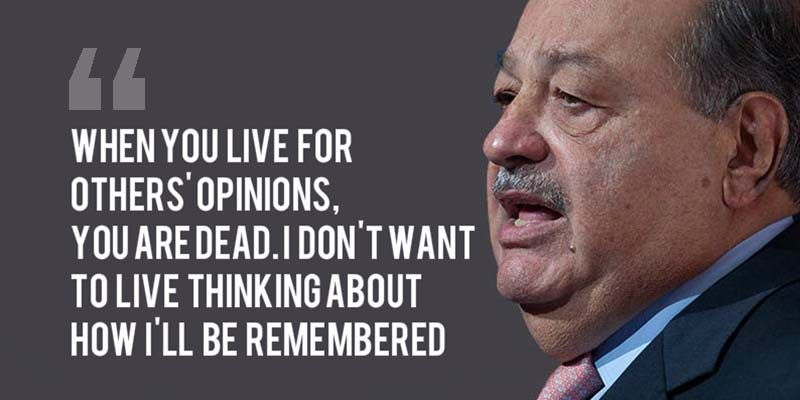Carlos Slim: The Three-time World’s Richest Man, Early Life, Investment Life and Net Worth
- Posted on December 06, 2019
- Featured
- By admin admin
Many
businesses choose to have a particular line of focus in order to properly
channel their resources and make a profit. Not Carlos Slim, a Mexican business
magnate, entrepreneur, investor, engineer, and philanthropist whose
conglomerate covers a majority of industries in the business sector including
finance, transportation, industrial manufacturing, retail, sports,
telecommunications, real estate, and education. A ‘Jack of all trades’ and a
master of all. For three consecutive years (2010 to 2013) Slim was named the
richest person in the world by Forbes. He ranks No.17 on the Forbes 2020 World's Billionaires list. He has a net worth of $53.1 as of May 27, 2020. He is also the largest
single shareholder of The New York Times. According to Forbes, Slim’s fortune
is both stemmed from his business deals and political connections as well.
Early life and education
Carlos Slim
Helu was born on the 28th of January 1940 to Julian Slim Haddad and
Linda Helu Atta in Mexico City. Like most successful business founders, Slim
had a keen interest in business and began to develop his interest. His father
took him lessons in management, finance, and accounting, and bookkeeping at an
early age. With the little knowledge of finance and business he received from
his father, he was able to invest in a government savings bond at the age of
11. Asides the interest he would receive from the investment, the investment
also provided him an opportunity to learn about compound interest. He had a
personal ledger where he daily saved all his business transaction records, a
practice he still keeps to till date. By 12, he was ready to start purchasing
shares, he purchased shares in a Mexican bank, which officially made it his
first stock purchase. Two years later, Slim had moved on from merely purchasing
stocks to being a shareholder in the largest bank in Mexico. Contributing to
interest in purchasing stocks, was the death of his father when he was 13.
He took up
his first job at the age of 17, working at his father’s company where he earned
200 pesos per week. He later enrolled at the National Autonomous University of
Mexico to study civil engineering. In his free time, he taught algebra and
linear programming. After his graduation from the University, he moved to Chile
where he took up courses in economics. His economics certification and
experience linear programming help set him on the right path towards going
further into the business world and reading financial statements.

Career History
By 1961,
after Slim had graduated from college, he got a job as a stock trader in
Mexico. Asides his work, Slim had other private investments, and by 1965 his
total profits from the investment had amounted to $400,000. With his profits,
he started Invesora Bursatil, a stock brokage; still within that year, he
bought Jarritos del Sur. And by the following year, he founded Inmobiliaria
Carso, a company worth $40 million.
By the
1970s, Slim had expanded his business focus to companies which specialized in
real estate, construction, mining, and bottling. Along the line, other
industries were included in his focus, companies such as paper and packaging,
tires, cement, retail, tobacco, auto parts, etc., his business expansion were
done through his company, Grupo Financiero Inbursa. Majorly, the company is
concerned with insurance, investments, savings, mutual funds, and pension
plans. Slim’s conglomerate allows him to buy stakes in almost every business
sector, that way, when there is a recession or if any business sector faces an
economic downturn, Slim’s conglomerate will still stay active unaffected by the
losses. Though some of his stocks may lose value in the market, however, a
financial downturn in one industry wouldn’t affect the others in the conglomerate.
That way Slim would always remain at the top of his game.
In 1976,
Slim acquired 60% (worth $1 million) shares of Galas de Mexico—a company that
printed cigarette-pack labels. Four years later, in 1980, he started Grupo
Galas, a company that had a particular interest in mining, construction,
retail, tobacco, and food. At a reduced price, Slim owned a majority stake at
Ciggaros la Tabacelera Mexicana which was the second-largest producer of
cigarettes as of 1981.
By the
early1980s, the Mexican economy began taken a downturn as a lot of banks were
financially unstable and many foreign investors were withdrawing. Slim stepped
in and acquired many firms at low values. The strategy was to buy as many
flagship companies as possible at a decreased value, and later resell them at a
higher price by the time the economy stabilized. He has applied this investment
strategy in all business deals to date. The basic idea was to buy undervalued
businesses with high returns potentials, run them for a while until cash flow
or simply sell them off when their value increases at higher prices.
As a
businessman with a keen eye for value and profit, Slim reinvested the profits
gotten from his businesses back into the businesses alongside other external
investments. By the 1980s, Slim’s conglomerate had expanded to having tobacco
and retail stores subsidiaries.
After the
Mexican government had privatized America Movil, a telecommunications company,
Slim through his Grupo Carso conglomerate absorbed the company. It has since
then become one of the major sources of Slim’s celebrated wealth. In 2012,
America Movil gained control of Telmex, another telecommunication company and
made it a subsidiary to Slim’s America Movil. As of 2012, Telcel controlled
about 70% of the market in mobile phone lines and 80% of landlines in Mexico.
America Movil invested $40 million in Shazam, a phone-based music
identification service, in July 2013. By investing in the company America Movil
was going to boost its growth and recognition levels, as well as increase its
value enough to bring in good profits.
By 2015,
Slim went fully into oil and gas, Carso Oil & Gas. Merged into this new
company were Carso Infraestructura,
Construccion y Perforacion, and Condumex
Perforanciones.

Investments from the early 2000s
●
Barnes & Noble,
OfficeMax, Office Depot, CompUSA, and Circuit City (2003)
●
Volaris, a Mexican
airline (2005)
●
Cigatam Tobacco Company
(2007)
●
New York Times (2008)
●
Tabasco Oil Co., (2011)
●
Pachuca and Leon, Mexican
soccer teams (September 2012): Investment made through America Movil
●
Mexican prisons for
management and business purposes (April 2013)
●
Shazam, a phone-base
music identification service company (July 2013): Investment made through
America Movil
●
Mobil, an Israeli startup
which deals with connecting people and communities with similar interests
(November 2013)
●
WellAware, an oil and gas
software developer based in Texas (July 2014)
●
IMatchative, a
financial-based technology startup (July 25, 2015): Investment made through
Control Empresarial de Capitales
●
Philosophy Jr., a fashion
line for young women (September 8, 2015)
Over the
years to date, Slim’s conglomerate has successfully thrived by expanding its
business tentacles all through the business sphere and made necessary
investments and reinvestments overtime to keep the profits rolling in. Slim may
be a ‘Jack of all trades’ but in the end, he is the master of all.
Net Worth
As of December
5, 2019, Carlos Slim is worth 60.7 billion
USD, but he could be worth more because he has many investments that are
unaccounted for at this moment. He is the king of business takeovers, an avid
investor and a man who runs multiple businesses. Also, he is considered to be
frugal because he lives in the same cheap home for 40 years.


Be the first to comment!
You must login to comment